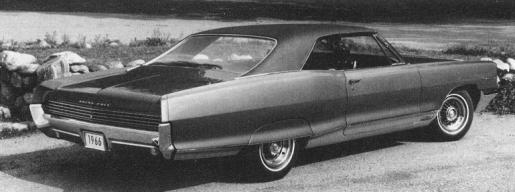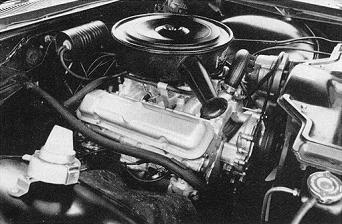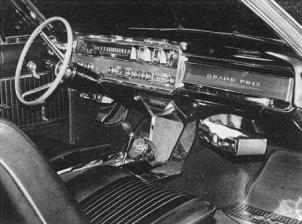| A clean, refined Grand Prix arrived 1966, and subtle changes in interior and exterior make this one of the most elegant cars of all time. Engine shown is the standard 325-hp 4-barrel/automatic 389. |
 |
 |
 |
1966
Styling-wise, the 1966 Grand Prix is to the 1965 version what the 1964 was to the 1963—the refining year in the usual two-year cycle. Whether or not the car was more attractive than the previous model is purely a matter of personal taste, but some consider it cleaner-looking than the '65 by virtue of its more sparing use of brightwork in the grille and taillight panel.
As in the 1964, frenched headlights replaced the previous year's chrome "eyebrows." The grille mimicked the 1964 X-400 show car with blacked-out plastic eggcrate grilles and turn signals in the same cavities, which curved toward the sharp, pointed nose, similar to the 1966 GTO. The GP's taillight panel featured chrome trim ribs, blacked out in between to give the impression of full-width taillights, although the lights were in fact conventional in size, hidden between the ribs at the ends.
The Grand Prix's engine lineup for 1966 was identical to 1965, except the 338-hp 389 Tri-Power was dropped. Someone probably figured out that it was a bit silly to have two engines with the same power rating, and chose the larger and simpler of the two.
Production continued to fall for the 1966 model year, as only 36,757 units were built, a scant 917 of which were ordered with manual transmissions.
The 1966 show season saw the debut of the Grand Corniche show car. It was a 1966 Grand Prix that was modified into a chauffeur-driven town coupe. The front of the roof was cut out, much in the same manner as in a T-top, but without the center bar. The rear roof section was not altered.
The car was finished in a Pearl Aqua with a matching Cordova vinyl top. The front bucket seats were covered in aqua-colored leather, while the rear seat upholstery was a combination of leather and cloth. Rather than going with the optional 8-lug wheels, Pontiac chose to go with nonproduction wire wheels. The tires were even unique, with three aqua-colored stripes instead of a single white one. The car's current whereabouts are unknown; it disappeared without a trace. It was most likely crushed after its show duties were completed.
In the next issue, we'll continue the Grand Prix history with the introduction of the 1967 models, and continue through the trend-setting G-body Grand Prix. We're sure you'll want to join us then.  NEXT >
NEXT >
|
|